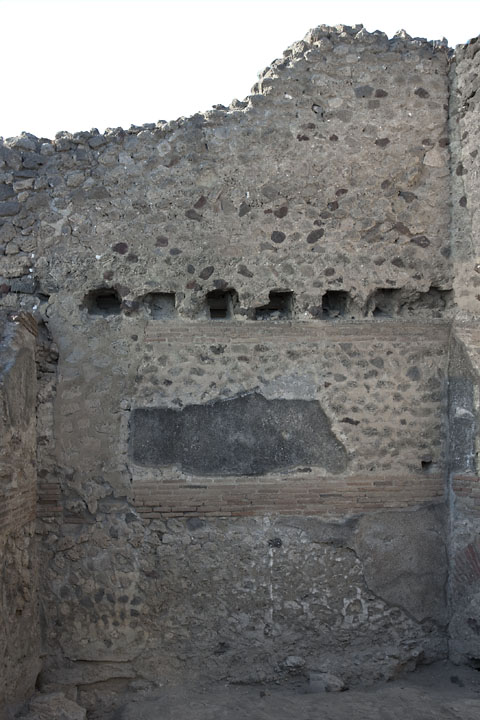North Wall
Description
Henrik Boman
The north wall is the only wall in room 6 with preserved beam holes. They are located just above the upper brick band at a height of c. 2.8 m.
As the E wall, uniformly constructed with to brick bands in the opus mixtum structure extending all over the building, and opus incertum in-between. The upper opus incertum wall built in limestone with some cruma and a few lava stones.
No signs of alterations, closed doors or windows are found in this wall. The only feature is the breach made by tunnellers close to the NW corner.
Spoils: The use of spoils in this wall is scare: a few tufa blocks of irregular shape visible in the upper part of the wall, one single fragment of a plaster/floor fragment is found.
Beam-holes: The beam-holes are seven in number (numbered 1-7 from west), the eastern found close to the east wall, the western some 0.4 m from W wall. Height of holes: 0.25 — 0.28 m. Width (imprint of beam): The beams have left some imprints in the plaster, in at least the four easternmost holes. Hole 6 is presumably filled with eruption debris, the while hole 7 is filled with stones and mortar, presumably modern material.
The wooden beams should have rested on the brick band, though a layer of mortar/plaster is preserved on top of the top brick, presumably to adjust the beams in level.
There are no visible traces of modern mortar or repair around the holes, and the fact that the wall on the opposite side is covered with plaster signified that the beam-holes in appearance are ancient. The holes extends through the wall, and the travers beam of the modern protection roof in V 1,31 is visible through the holes. The supporting beams for the roof in V 1,31 are well masoned in the ancient wall, and the construction must have affected the beam-holes in room 6.
The second floor: The beam-holes show us that there was a second floor above this room (at least). There are no signs of communication to the upper floor inside room 6: the narrow spacing of the beam-holes does not give us any clue to the access to the second floor. There is a possibility of communicated with other part of the taberna since the walls to rooms 2 & 7 are not preserved in a manner that could rule out a door or window. The appearance of the north and east wall rules out any communication, doors or windows, to the surrounding buildings outside V 1,1.32.
The upper wall V 1,31 is covered with plaster, signifying that the upper part of the wall in room 6 is original and the beam-holes reflects the original design of the wall and room 6, even if the cork model in Naples do not show these beam-holes.
Plaster: Plaster is preserved between and below the brick bands. The plaster has the same character as on the E wall: The plaster is heavily weathered. The plaster has with large particles exposed in the surface, of c. 2-3 mm in size. The lime is fairly white, with a tint of grey, domination the unexposed plaster giving it a whitish tone. No traces of the fine lime coat, color or the decoration of the plaster remains.
Large parts of the wall (specially a large surface between the brick bands) have the yellow smooth mortar surface found underneath the plaster, indicating that the plaster might have fallen of not too long ago. However, no remains of plaster fragments were found fallen of the wall.
The tunnellers breach A breach continues up to the beam-holes (upper brick band also destroyed in this area) and the most western beam-hole might be a reconstruction. It is difficult to establish an exact limit for the breach. The breached brick bands (both lower and upper) are not mended with brick. The hole is mended with stones and mortar in different yellow tone.

